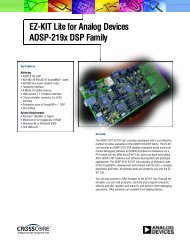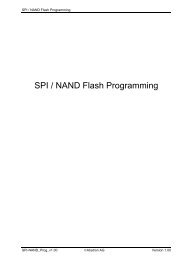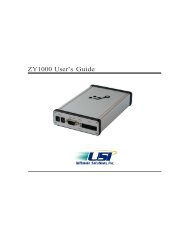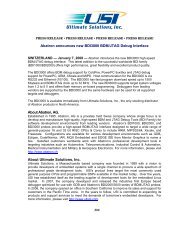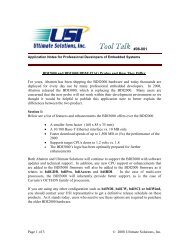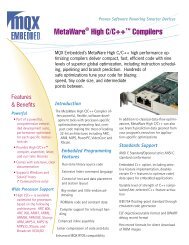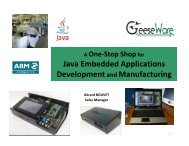STM32 Journal - Digikey
STM32 Journal - Digikey
STM32 Journal - Digikey
Create successful ePaper yourself
Turn your PDF publications into a flip-book with our unique Google optimized e-Paper software.
<strong>STM32</strong> <strong>Journal</strong><br />
Bringing 32-bit Performance<br />
to 8- and 16-bit Applications<br />
By Reinhard Keil, Director of MCU Tools, ARM Germany GmbH<br />
Shawn Prestridge, Senior Field Applications Engineer, IAR Systems<br />
Sean Newton, Field Applications Engineering Manager, STMicroelectronics<br />
Today’s embedded applications<br />
are being called upon to<br />
provide an increasing number<br />
of capabilities. More and more<br />
devices need to be connected,<br />
require greater precision, must<br />
offer a graphics-based interface<br />
with touch capabilities, utilize<br />
sophisticated signal processing,<br />
and support multimedia playback.<br />
In the past, developers were<br />
compelled by cost constraints<br />
to base their designs on 8- and<br />
16-bit architectures that limited<br />
performance. Now, with the<br />
availability of next-generation<br />
MCUs like the <strong>STM32</strong> F0 that<br />
provide 32-bit performance<br />
at 8-bit budget pricing, OEMs<br />
can bring substantial value to<br />
end-users without having to<br />
compromise functionality. In<br />
addition, powerful development<br />
tools like Keil’s MDK-ARM and<br />
IAR Embedded Workbench<br />
enable developers new to 32-<br />
bit programming to immediately<br />
exploit the full capabilities of the<br />
<strong>STM32</strong> F0 architecture.<br />
The 32-bit Advantage<br />
There are several ways in which<br />
the <strong>STM32</strong> F0 lowers product<br />
cost compared to 8- and 16-bitbased<br />
designs. Specifically,<br />
because these MCUs tend to be<br />
based on legacy architectures,<br />
they have many limitations that<br />
slow development by forcing<br />
designers to work around the<br />
architecture, so to speak. For<br />
example, to complete a 16 x 16<br />
multiplication for a processing<br />
algorithm, a 16-bit CPU requires<br />
four multiplies and several<br />
additions, depending upon the<br />
implementation. An 8-bit CPU<br />
would require significantly more<br />
cycles. With the <strong>STM32</strong> F0, this<br />
takes a single instruction.<br />
The result is code that makes<br />
better utilization of MCU<br />
resources, leading to faster<br />
operation, more performance per<br />
MHz, higher code density, and<br />
greater power efficiency. Since<br />
each instruction does more per<br />
clock cycle, applications can be<br />
written using less code. In addition<br />
to accelerating development,<br />
shorter code is easier to debug as<br />
well. Together, all of these benefits<br />
lead to lower system cost.<br />
Cost, however, is only one of<br />
the numerous advantages the<br />
<strong>STM32</strong> F0 has over 8- and 16-<br />
bit architectures. The <strong>STM32</strong><br />
F0 is a full embedded MCU<br />
built using the same <strong>STM32</strong><br />
DNA that the rest of the <strong>STM32</strong><br />
family has, including excellent<br />
real-time performance, DMA,<br />
high-resolution ADC and DAC<br />
peripherals, motor control<br />
timers, and connectivity<br />
interfaces. These integrated<br />
capabilities bring tremendous<br />
efficiency to cost-sensitive<br />
designs in a way that limited<br />
8- and 16-bit MCU architectures<br />
cannot (see Figure 1).<br />
For example, the availability of<br />
a 32-bit bus not only speeds<br />
data transfers and increases<br />
computing performance, it<br />
improves system reliability.<br />
Consider the challenge of reading<br />
a 12-bit DAC using an 8-bit bus<br />
where the CPU has to read the<br />
DAC twice to capture the entire<br />
sample. If an interrupt occurs<br />
between these reads, the DAC<br />
data may be overwritten by the<br />
next sample before the interrupt<br />
is completed and the second<br />
read can be executed. To prevent<br />
this, developers have to manually<br />
disable interrupts for every<br />
such “atomic” operation in an<br />
application. If even one instance<br />
is missed, this creates a potential<br />
for an intermittent error that will<br />
be extremely difficult to resolve.<br />
DMA: Moving Data<br />
Efficiently<br />
The <strong>STM32</strong> F0 is a modern<br />
architecture integrating the<br />
3




